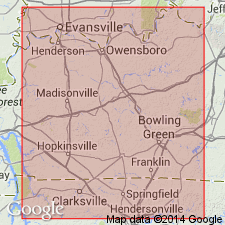
- Usage in publication:
-
- Curdsville substage
- Modifications:
-
- Original reference
- Dominant lithology:
-
- Limestone
- AAPG geologic province:
-
- Cincinnati arch
Summary:
Pg. 9, 18. Curdsville substage [Curdsville limestone]. Cherty crystalline limestone, 30 feet thick, characterized by DINORTHIS PECTINELLA. Overlies Highbridge limestone and underlies Logana bed. Basal formation of Lexington stage. Age is Middle Ordovician (Mohawkian; Trenton).
[Named from Curdsville Station on the Q & C RR, Mercer Co., central KY.]
Source: Publication; US geologic names lexicon (USGS Bull. 896, p. 556).
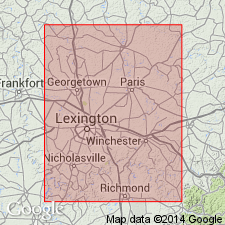
- Usage in publication:
-
- Curdsville limestone*
- Modifications:
-
- Revised
- AAPG geologic province:
-
- Cincinnati arch
Summary:
Pg. 41. Curdsville limestone. Basal formation in Lexington group in Kentucky. Consists of cherty coarsely crystalline gray-blue limestone, about 20 feet thick. Underlies Hermitage formation; overlies Tyrone limestone of Highbridge group. [Age is Middle Ordovician.]
[Curdsville limestone of Lexington group adopted by the USGS.]
Source: US geologic names lexicon (USGS Bull. 1200, p. 1009); supplemental information from GNU records (USGS DDS-6; Reston GNULEX).
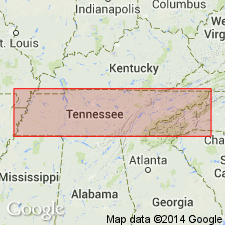
- Usage in publication:
-
- Curdsville limestone member
- Modifications:
-
- Revised
- AAPG geologic province:
-
- Cincinnati arch
Summary:
Pg. 84 (fig. 15), 85-88; C.W. Wilson, Jr., 1939 [abs.], GSA Bull., v. 50, no. 12, pt. 2, p. 1993. Curdsville limestone member of Hermitage formation. Is member at base of Hermitage formation in central Tennessee. Consists of thin beds of medium-grained to coarsely crystalline blue to gray limestone interbedded with partings of gray shale. Maximum thickness 15 feet. Overlies Carters limestone of Stones River group. [Age is Middle Ordovician.]
Source: US geologic names lexicon (USGS Bull. 1200, p. 1009).
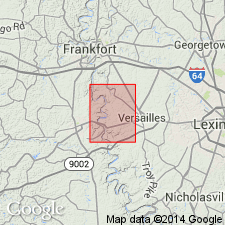
- Usage in publication:
-
- Curdsville Member*
- Modifications:
-
- Revised
- AAPG geologic province:
-
- Cincinnati arch
Summary:
Rank reduced to Curdsville Member of Lexington Limestone. Basal member, overlying Tyrone Limestone and underlying the Logana Member of Lexington. Thin- to thick-bedded, fine- to medium-grained, slightly phosphatic, fossiliferous limestone and minor shale. 27-31 ft thick.
Source: GNU records (USGS DDS-6; Reston GNULEX).
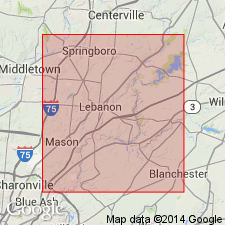
- Usage in publication:
-
- Curdsville Member
- Modifications:
-
- Areal extent
- AAPG geologic province:
-
- Cincinnati arch
Summary:
Nomenclature of the Lexington in this report follows Stith (1986: OH Rept. Inv. 132) who extended the Curdsville and Logana Members to OH. Upper Lexington is undifferentiated and gradationally underlies Point Pleasant Formation in southwestern OH.
Source: GNU records (USGS DDS-6; Reston GNULEX).
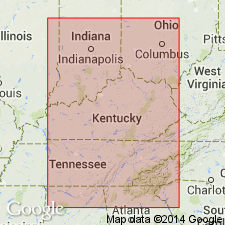
- Usage in publication:
-
- Curdsville Limestone Member*
- Modifications:
-
- Overview
- AAPG geologic province:
-
- Cincinnati arch
Summary:
The Curdsville Limestone Member is the basal member of the Hermitage Formation in central TN and the basal member of the Lexington Limestone in KY. Consists of bluish gray, thin- to medium-bedded, coarsely crystalline limestone. Fossils include brachiopods, bryozoans, mollusks, trilobites, corals, crinoids, and ostracodes. The unit onlaps the Carters Limestone on the flanks of the Nashville dome in TN where the thickness is 7 feet on the western flank and 10 to 15 feet on the eastern flank and absent over the top of the dome. Unconformably overlies the Carters Limestone of the Stones River Group and underlies the laminated argillaceous member of the Hermitage in TN. In KY, the Curdsville is 20 to 40 feet thick, unconformably overlies the Tyrone Limestone of the High Bridge Group and underlies either the Logana Member or the Grier Limestone Member of the Lexington Limestone. The Curdsville is interpreted to be deposited in a shallow subtidal, normal marine, transgressive environment.
Source: GNU records (USGS DDS-6; Reston GNULEX).
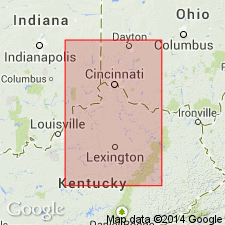
- Usage in publication:
-
- Curdsville Limestone Member*
- Modifications:
-
- Age modified
- AAPG geologic province:
-
- Cincinnati arch
Summary:
Age of Curdsville Limestone Member of Lexington Limestone in KY is Champlainian (Kirkfieldian).
Source: GNU records (USGS DDS-6; Reston GNULEX).
For more information, please contact Nancy Stamm, Geologic Names Committee Secretary.
Asterisk (*) indicates published by U.S. Geological Survey authors.
"No current usage" (†) implies that a name has been abandoned or has fallen into disuse. Former usage and, if known, replacement name given in parentheses ( ).
Slash (/) indicates name conflicts with nomenclatural guidelines (CSN, 1933; ACSN, 1961, 1970; NACSN, 1983, 2005, 2021). May be explained within brackets ([ ]).

